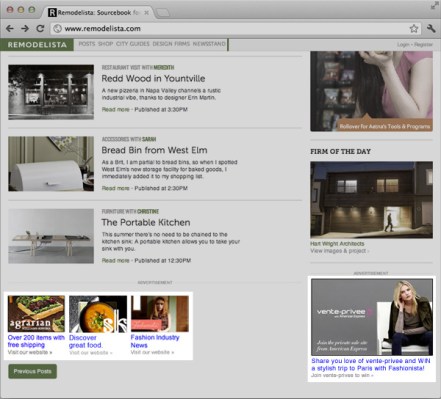Back in February, comScore released a statistic that was probably pretty discouraging if you’re an online advertiser: In a study, it found that 31 percent of ads delivered were never actually seen by consumers. If you’re paying by the ad impression, that’s a lot of wasted money. Now online publishing and advertising company SAY Media has come up with one way to solve the problem, through a measurement called “cost per exposure.”
CEO and co-founder Matt Sanchez says that since “we have a proprietary technology stack,” SAY can communicate with the browser and determine whether an ad was actually seen. That doesn’t mean it’s literally tracking where you’re looking, but it can tell whether the ad actually loaded within your browser window. So when SAY says it’s charging “per exposure,” advertisers don’t have to pay for ads that viewers never scrolled down to see, or that they scrolled past before the ad loaded. Sanchez says he’s hoping other publishers start adopting a similar system.
“We really wanted to move the debate forward,” Sanchez says. “Instead of thinking about how to serve the most ads, publishers can start thinking about how to create value and how to relate advertising to content.”
SAY isn’t just doing this to advance the cause of accountable advertising. It’s also announcing a new advertising unit, called Content Ads. Until now, SAY and its “Clean Campaign” strategy have focused on big ads that are priced for engagement, rather than impressions. Sanchez says the company wanted to create ad units that could serve companies that were a good fit for SAY’s sites but didn’t want to pay for the engagement ads. For example, he says private a retailer might want to advertise on Fashionista, but might not have the budget for or interest in a “big, high impact advertising campaign.” Content Ads are smaller, “lightweight” ad units that should, as the name implies, feel like content — they should usually come from advertisers who match the site’s editorial mission. And it didn’t make sense to price these new ads on the engagement model, so SAY came up with the cost-per-exposure plan. (Put another way, this allows SAY to run more ads per page, without appearing to completely go back on its “Clean” strategy.)
Sanchez says Content Ads are limited to sites that SAY Media owns and represents exclusively on the ad side, while cost-per-exposure pricing is available all across the company’s ad network.
